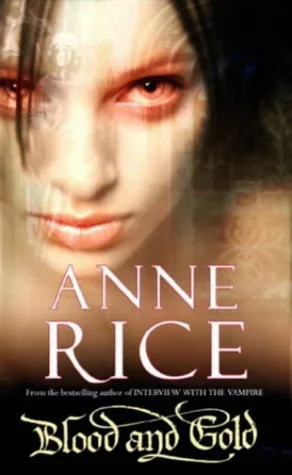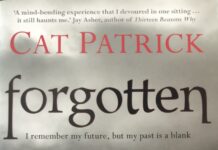In the realm of gothic literature, few authors have woven the intricate threads of darkness and desire with the finesse of Anne Rice. Her novel, “Blood and Gold,” serves as both a haunting tale and a deep exploration of the human experience through the eyes of its immortal characters. Transporting readers to a world where time is elastic and moral boundaries blur, Rice invites us to delve into the lives of those who have embraced eternity amid the shadows of their own making.This review aims to illuminate the rich themes and compelling narratives within “Blood and Gold,” examining how Rice crafts a story that resonates with both the allure and the agony of eternal longing. Join us as we embark on a journey through the pages that meld history, philosophy, and the very essence of what it means to desire—both life and death.
Immersive World-Building: How Anne Rice Crafts an Alluring Underworld of Vampiric lore
Anne Rice’s storytelling entwines the reader in a tapestry rich with past nuance and sensory detail.In ‘Blood and Gold,’ she introduces the world of vampires not just as creatures of the night, but as beings steeped in the complexities of human and supernatural history. Each scene resonates with the essence of the locales, from the misty streets of ancient Rome to the candle-lit chambers of medieval Europe, crafting an immersive experience that transcends mere words. Through lush descriptions, rice invites her audience to explore the temporal layers of her characters, revealing the intricate connections they maintain with the past and each other.
The depth of vampire lore presented in the novel is a testament to Rice’s dedication to myth-making. She doesn’t shy away from examining the duality of existence that her characters embody; they are both monstrous and profoundly human, torn between their desires and their predatory nature. The following elements play pivotal roles in establishing this captivating underworld:
- Rich Character Arcs: Characters evolve through their internal conflicts.
- Complex Morality: explores the gray areas of good and evil.
- Historical context: Weaves real historical events into the storyline.
- Poetic Prose: Language that enchants and engages the reader’s senses.
A Character Study of Marius: The Complexity of Immortality and Its Burdens
Marius emerges as a profoundly intricate character in Anne Rice’s narrative tapestry, embodying the endless divide between the allure and anguish of immortality. His existence transcends centuries, weaving through the streets of ancient Rome and the grand halls of art and culture. this timelessness, while enchanting, comes at a steep price. Marius grapples with profound existential dilemmas, encapsulating the seductive nature of eternal life alongside its associated burdens. Key aspects of his character reveal a man tormented by loss, driven by an insatiable quest for true connection, highlighting his inner conflict:
- Longing for Humanity: Marius often craves the warmth of human relationships, yet fears their certain fragility and loss.
- Artistic Expression: his deep thankfulness for beauty serves as both a sanctuary and a reminder of what he cannot permanently possess.
- Moral Ambiguity: Marius’s choices reflect a complex ethical landscape, challenging the reader to ponder the moral implications of his actions.
Beyond the realm of his personal struggles, Marius encapsulates a philosophical approach to life’s enduring questions. The contrast between the golden moments of his existence and the darkness that shadows him emphasizes the profound loneliness that accompanies his immortality. In his relationships, particularly with figures like the legendary vampire Lestat, we see the duality of love and despair intertwine. This pattern of emotional interplay is best summed up in the table below:
| Emotion | Significance |
|---|---|
| Desire | represents the yearning for connection and understanding. |
| Loneliness | Presents the deep isolation felt despite being surrounded by others. |
| Hope | signifies the ever-present longing for redemption and love. |
Love and Loss in the shadows: Exploring Relationships in a Dark Fantasy
Anne Rice masterfully intertwines themes of love and loss within the dark tapestry of Blood and Gold, illuminating the complexities of human (and vampire) relationships in a world where shadows reign. Within the lives of her characters, we find an exploration of passion forged in the fires of tragedy, where every moment of connection is tempered by the threat of separation.The struggle between yearning and despair becomes palpable as lovers navigate their dark destinies, trapped in an eternal cycle of devotion and heartache. Here are some poignant elements that define these relationships:
- Unquenchable Desire: The characters’ insatiable longing drives them into the embrace of darkness.
- Bitter Regret: Past decisions haunt them, creating a rift between love and forgiveness.
- The Weight of Immortality: Eternal life magnifies every emotion, making love simultaneously exhilarating and painful.
In this haunting narrative, the shadow of loss looms large, often manifesting as a specter that shapes the desires of the living and undead alike. As the characters grapple with their fears—weather it be losing a loved one or confronting the inevitability of change—we witness the depths of their relationships unfold in a dance of light and dark. The exploration of these bonds is not just a reflection of their inner turmoil but also a mirror of the choices that define them. The intertwined nature of love and grief leads to difficult yet beautiful revelations, highlighting the delicate balance of connection in a world where every heartbeat could be their last.
| Theme | Impact on Relationships |
|---|---|
| Immortal Longing | Fuels an endless pursuit of connection |
| Tragic Loss | Deepens emotional bonds and scars |
| Forbidden Love | Creates tension and urgency in relationships |
The role of History: Melding Real Events with Fictional Narratives
Anne Rice’s narrative prowess lies in her ability to intertwine factual history with her captivating tales, creating a rich tapestry that engages readers on multiple levels. In Blood and Gold, she artfully sketches a world that mirrors historical realities, particularly the tumultuous period of the Roman Empire and its impact on European civilization. the character of Marius de Pontmercy, a vampire with a storied past, serves as a vessel through which readers navigate the intersections of power, culture, and mortality. Here, Rice invites us to consider how historical atrocities and triumphs shape personal identities, unraveling the complex threads that tie human experience to both light and darkness.
Through her unique blend of history and fiction, Rice also addresses themes of love, loss, and eternal longing, inviting comparisons between historical figures and her immortal creations. Marius’s journey embeds him within a framework of real events,echoing the struggles of artists and philosophers of the age. This deliberate merging creates a resonant backdrop for exploring personal desires and moral ambiguity. The episodic nature of his adventures also reflects a larger narrative arc where philosophy, religion, and art intersect, allowing readers to ponder the implications of living through history—both as a spectator and an active participant.
Themes of Desire and Power: What Drives the Actions of the Immortal
In Anne Rice’s *Blood and Gold*, the exploration of desire and power emerges as a backdrop that intricately shapes the actions and motivations of the immortal characters. Central to this narrative is the dynamic interplay between personal longing and the pursuit of dominance, which often leads to a chaotic collision of interests among the vampires. These beings, living for centuries, are driven by an unquenchable thirst—not just for blood, but for connection, control, and transcendence. Key themes manifest through various veins, including:
- Romantic Obsession: Characters grapple with intense attachments that blur the lines between love and possession.
- Moral ambiguity: The immortality of the vampires spurs conflicting desires that challenge notions of right and wrong.
- Control of Fate: Each immortal strives to define their destiny amidst the haunting predicaments of their existence.
The quest for power, intertwined with the rich tapestry of desire, unveils the darker nuances of the immortal psyche. As they navigate eternal life, they wrestle with the consequences of their choices, often reflecting the duality of their existence: the desire to feel deeply while maintaining a grip on supremacy within their nocturnal world.This tension is astutely captured through key interactions and pivotal moments, exemplifying how:
| Desire | Power Dynamics |
|---|---|
| Yearning for Love | Manipulating Relationships |
| Seeking Connection | Establishing Dominance |
| Overcoming Isolation | Controlling Fate |
Through these profound themes, Rice deftly examines how the immortals’ perennial struggles illuminate the complexities of human emotion and ambition, encapsulating an enduring allure that keeps readers engrossed in their labyrinthine lives.
The Allure of the Gothic: Atmospheric Writing That Evokes Deep Emotion
Anne Rice masterfully weaves a tapestry of darkness and desire in her novel ”Blood and Gold.” The atmosphere she creates is dense with history, desire, and the lingering scent of dread.Characters are not merely portrayed; they are immortal embodiments of their emotions, navigating the complexities of love and betrayal in an eternal twilight. The streets of ancient cities come alive as her vivid descriptions transport readers to the heart of the eerie and the enchanting. key themes resonating throughout the narrative evoke a sense of melancholy and nostalgia, reflecting the soul’s deep yearning for connection amidst chaos.
The novel’s allure lies in its ability to summon a range of emotional responses, drawing readers into a world where the grotesque and the beautiful are intertwined. The juxtaposition of immortality and human passion creates a palpable tension, making the characters’ struggles more relatable. Noteworthy elements include:
- Dramatic landscapes: Capturing the decay and beauty of bygone eras.
- Complex relationships: Exploring the nuances of love, longing, and loneliness.
- Philosophical reflections: Contemplating existence and the weight of timelessness.
This rich and evocative atmosphere is meticulously crafted, immersing us in a gothic dream where every page reverberates with the whispers of the eternal night.
Philosophical Underpinnings: The Existential Questions within Immortal Life
Anne Rice’s narrative intricately weaves existential themes, positioning the quest for meaning against the backdrop of eternal life. Characters grapple with questions of identity, purpose, and the nature of existence itself while navigating their immortal realities.This creates a profound dichotomy between the yearning for undying life and the existential dread that accompanies it. Readers are invited to ponder:
- What does it mean to live without an end?
- How does immortality alter one’s sense of self and relationships?
- Can one genuinely experience joy or love when detached from the inevitability of death?
Moreover, the interplay of darkness and desire serves as a potent catalyst for self-discovery and transformation. The characters, often haunted by their pasts, reflect on the darker facets of their existence and the desires that arise from their immortal condition. This entanglement leads to philosophical explorations, such as:
| Existential Themes | Character Reflection |
|---|---|
| Search for Identity | How to define oneself beyond mortality? |
| Desire and Isolation | Can eternal life fulfill one’s desires? |
| The Nature of Suffering | Is suffering inevitable, even in immortality? |
Through these layered explorations, Rice invites us to scrutinize our definitions of meaning, connection, and desire, revealing the deep philosophical questions that echo within the immortal life she so vividly portrays.
Visual Imagery and Symbolism: A Rich Tapestry of Meaning in Blood and Gold
At the heart of Anne Rice’s narrative lies a complex interplay of visual imagery and potent symbolism, where every page seems to pulse with the duality of life and death. The lush descriptions of the natural world contrast sharply with the stark realities of a vampire’s existence, employing rich visual elements that evoke both beauty and horror. The golden hues of dawn represent fleeting moments of hope, while the deep, claret red of blood serves as a visceral reminder of mortality and desire. Through this exploration, Rice invites readers to immerse themselves in a landscape where shadows dance with light, creating a captivating tapestry woven with contrasting threads of passion and despair.
Symbolism in Rice’s work often transcends mere aesthetics; it serves as a gateway to understanding the profound emotional struggles of her characters. For instance, the recurring motifs of flowers and decay illustrate the transient nature of beauty in the face of immortality. The elegant petals represent a longing for connection, while their inevitable wilting signifies the isolation that comes with eternal life. Additionally, symbols of gold permeate the narrative, representing both wealth and the corruption it can encourage—hinting at the duality of power, whether it manifests in the allure of riches or the burden of eternal longing. These themes coalesce to create a rich and thought-provoking experience that lingers long after the final page is turned.
Narrative Pacing: Balancing Introspection and Action in a Dark Tale
In “Blood and Gold,” Anne Rice masterfully navigates the delicate interplay between introspection and action, crafting a narrative that pulls readers into the depths of her characters’ psyches while simultaneously driving the plot forward. This balance is particularly evident in the character of M. F. Renaud, whose internal struggles and existential musings are juxtaposed against the backdrop of a tumultuous historical landscape. Readers find themselves immersed in his reflections on immortality, desire, and the burdens of existence in a world marked by darkness. Rice employs a rhythmic pacing that slows during moments of introspection, allowing space for the reader to ponder alongside Renaud, before snapping back into the frenetic pace of his adventures, amplifying the tension inherent in both the personal and the external conflicts he faces.
Additionally, the narrative’s structure cleverly employs flashbacks and interludes that enrich the story while providing necessary context.These moments serve not only to deepen character development but also to illuminate the motivations behind their actions, crafting a robust tapestry of interconnected lives. A well-placed table displaying key themes and their manifestations throughout the text can further highlight this dynamic:
| Theme | Manifestation |
|---|---|
| desire | Drives characters into perilous situations |
| Isolation | Introspective moments create intense personal reflections |
| Power | Action-driven circumstances reveal the struggle for dominance |
Ultimately, Rice’s deft handling of pacing not only adheres to the conventions of a dark tale, but also elevates the narrative by intertwining profound insights with gripping action. This harmony cultivates a reading experience that resonates long after the last page is turned,compelling readers to reflect on the complexities of light and shadow within themselves.
Recommendations for Fans of Dark Fantasy: Who Will relish This Novel?
Fans of dark fantasy will find their creativity ignited by Anne Rice’s vivid storytelling and intricate world-building in ‘Blood and gold’. This novel is tailored for readers who relish the complexity of morally ambiguous characters and the kind of lush prose that lingers in the mind long after the page is turned. If you’re drawn to tales that intertwine elements of desire, loss, and the supernatural, you’ll likely feel an immediate connection to the enigmatic world that Rice crafts.Whether you’re a seasoned aficionado of her work or new to the genre, this novel offers a rich tapestry of themes, ensuring that it speaks to various sensibilities and preferences.
The following readers will especially relish this tour into the depths of fantasy:
- Fans of Gothic literature - the dark and moody atmosphere will resonate strongly.
- Character-driven story enthusiasts - the profound character arcs invite deep emotional investment.
- Lovers of Romantic tension – the interplay of passion and danger fuels many compelling moments.
- Readers seeking historical context - The rich historical references provide a grounding for the supernatural elements.
Within the novel, readers may also find specific themes appealing, as summarized in the table below:
| Theme | Appeal |
|---|---|
| Immortality | explores existentialism and the weight of eternal life. |
| Desire | Delves into lust and longing amidst darkness. |
| Family Legacy | Examines the bonds and burdens of ancestry. |
Comparative Insights: Blood and Gold Within the Context of Anne Rice’s Work
Anne Rice’s intricate tapestry of vampiric mythology often intertwines themes of despair, immortality, and the eternal quest for love. In Blood and Gold, we find a rich exploration of the dualities that characterize her universe—specifically the interplay between light and dark, desire and despair, and the complexities of existence itself. The character of Marius presents a striking contrast to the more predatory figures frequently enough found in Rice’s canon, showcasing a more philosophical approach to immortality.His journey through centuries reflects not only the burden of his life choices but also the profound emotional connection to his creations, as he navigates the intricate dance of becoming both lover and creator.
The interplay of gold as a symbol within the narrative also deserves attention. While it typically signifies wealth and power, rice transforms it into a representation of opulence without fulfillment. Marius’s interactions with other immortal beings highlight the often hollow nature of supernatural relationships that can be forged in an endless existence. This notion brings forth the idea that perhaps the greatest treasures lie not in the accumulation of wealth or power but in fleeting moments of genuine human connection, which are equally fleeting for those cursed with immortality. The table below encapsulates these dualities and the thematic relevance in the context of Marius’s character:
| Theme | Marius | Common vampire Archetype |
|---|---|---|
| Love | Profound and tragic | Predatory and fleeting |
| Existence | Philosophical burden | Incessant hunt for meaning |
| Wealth | Symbolic of loneliness | Means to power |
Legacy of Anne Rice: the Enduring Impact of a Pioneer in Gothic Fiction
Anne Rice’s influence on the gothic genre cannot be overstated. Through her vivid storytelling and deeply complex characters, she redefined the vampire archetype and introduced readers to a world where darkness and desire coexist, challenging conventional notions of morality and humanity. Her novels not only delved into the supernatural; they explored the rich tapestry of human emotions, inviting readers to confront their own fears and desires. Rice’s work is characterized by:
- Layered Characterization: Each figure is crafted with depth, revealing the struggles of immortality and longing.
- Gothic Aesthetics: Her lush descriptions create a haunting atmosphere that immerses the reader in a world both beautiful and grotesque.
- Philosophical Questions: Rice’s narratives frequently enough grapple with themes of existence, morality, and the nature of evil.
The legacy of Anne Rice has paved the way for a new generation of authors who dare to traverse the darker path of literature.Her ability to intertwine tragedy and sensuality has inspired countless works, cementing her status as a pioneer in gothic fiction. In many contemporary narratives, one can trace the echoes of Rice’s impact, from the tortured protagonists who grapple with their identities to the intricate world-building that evokes a sense of dread and allure. The following table highlights a few key authors and their notable works that reflect Rice’s enduring influence:
| Author | Notable Work | Connection to Rice |
|---|---|---|
| Stephen King | the dark Half | Explores duality and the monstrous self. |
| Gwendolyn Kiste | The Rust Maidens | Blends horror with themes of femme fatale and loss. |
| V.E. Schwab | Vicious | Examines power, desire, and the consequences of ambition. |
Final Thoughts
“Blood and Gold” offers a rich tapestry woven with the threads of darkness, desire, and the eternal quest for identity.Anne Rice delves deep into the psyche of her protagonist, Marius, inviting readers to navigate the labyrinth of his immortal existence. While the book may not satisfy every craving for action, its introspective nature reveals the profound complexities of love, loss, and the burdens of immortality. For those who relish the exploration of the human—and inhuman—condition through a gothic lens, this installment of Rice’s saga promises to be both a haunting and enlightening journey. Ultimately, “Exploring darkness and Desire” serves as a reminder that even in the depths of despair, the quest for understanding and connection remains an indelible part of the human experience. As you close the book, may you carry forward the echoes of Marius’s struggles, pondering the delicate balance between light and shadow that resides within us all.




















